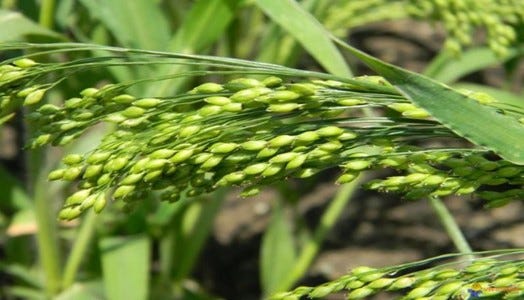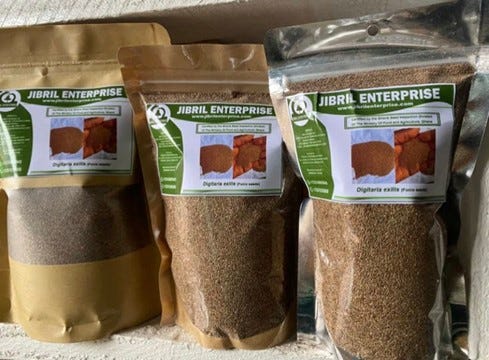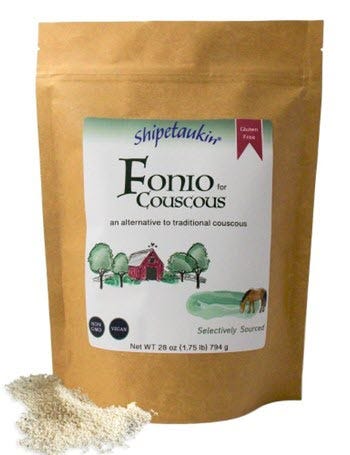Fonio is an ancient grain that is not very well known to the public. It comes from northwest Africa from a region bordering the Sahara Desert known as the Sahel. Fonio is being touted as one of the most nutritious grains in the world, and foodies in the know are abandoning Quinoa for it.
This week’s Medical Underground is taking a deep dive into Fonio, primarily because of my belief that this is among a handful of foods that can be grown and harvested more than once a season and provide your family with a nutritious food source that might very well save their lives.
What Exactly is Fonio?
Fonio is the African term for two cultivated grasses from northwest Africa. The botanical family name is Digitalis, which in cooler climates is related to our crabgrass. In western Africa it grows like a grain as you can see in the photo above. It is considered an ancient grain, like millet. Fonio is a nutrient rich, whole grain, high in fiber, and plant-based proteins.
The two species of Fonio grown in North Africa are white Fonio or Digitalis exilis, and black Fonio or Digitalis iburua. When you buy Fonio seeds they are almost all white Fonio. Black Fonio has more protein but is rarely exported. So, for the rest of this article whenever I am referring to Fonio, I will be referring to white Fonio unless otherwise mentioned.
White Fonio has other names mostly from Europeans, who refer to it as hungry rice or Acha rice. The reason for the name hungry rice is that they often saw poor Africans eating it, especially in hard times. Something perhaps to keep in mind for our own futures as our insane world leaders prepare for an unthinkable World War III.
African tribesmen living in one of the most inhospitable climates on Earth, the Sahel, used many indigenous plants for their survival and among them Fonio was a superstar. The Sahel is semiarid land adjacent to the Sahara Desert, with scant rainfall and very poor soil, yet Fonio thrives there. Africans have been eating Fonio for over 5,000 years.
Amazingly, Fonio reaches maturity in as little as six to eight weeks! Farmers harvest the upper third containing the seed heads and use the dry stalks below it as a source of feed for their goats. After that they plow the remains into the soil which improves its fertility! I love that nothing gets wasted, what an amazingly useful food crop.
For our purposes, a six-to-eight-week growing season could translate into three crops a year, or at the very least two. That is amazing for a nutritious grain such as this.
One thing to keep in mind when growing Fonio, is that when it first emerges from the soil it competes poorly with weeds, so you must mulch it heavily and weed it to get the best production.
If you are growing it at home, remember it does not need much water, just a lot of direct sunlight. Mulch it well with some hay or straw and watch it grow.
Once harvested, Fonio is used to make porridge, couscous, bread, and beer. Fonio beer, I wonder how that would taste. It has to be better than Bud Light, which has left a bad taste in everyone’s mouths. Good for them, they deserved that.
What they should have done is go out the next day and say, “Guys, we really screwed up, what the hell were we thinking? Bud Light will be half off for the next month as an apology for our stupidity”. But no, they doubled down on their transgender wokeness, and the most popular brand in America crashed and lost billions of dollars. Which is exactly what they deserved, Go Woke and Go Broke. However, I digress.
What Are the Health Benefits of Fonio?
Just the fact that Fonio has been consumed for over five thousand years tells you all you need to know about its usefulness as a food crop. Now, let’s see why it has lasted so long as a food source.
Fonio grain is very small, size wise it is like a cross between couscous and quinoa, but when you cook it, it puffs up to four times its original size! And that is just the start of its good news.
Blood Glucose Management and Diabetes
Fonio has been touted as being good for aiding in blood glucose management. It does this because it contains resistant starches, that are not able to be digested in the small intestine and hence do not spike glucose levels in the blood. The same resistant starches of Fonio also aid in digestion by various methods outlined below in my “Kinky Fact/Nerd Food” section. Fonio has a low glycemic index meaning it does not raise blood glucose levels, hence helps control pre-diabetes and diabetes.
Kinky Facts/Nerd Food:
As always, you can skip these if you are not interested in taking a deep dive into science. In this case I will explain what Resistant Starches are, and why our bodies love them.
First, starches are long chains of folded up glucose (sugar) molecules. Most starches are easily digested by our body in the small intestine, causing a consequent spike in our blood sugar levels.
These glucose or sugar spikes cause the release of insulin, which the body releases to drive sugar into cells lowering blood levels. Chronically high insulin levels eventually lead to insulin resistance and is the cause of the current epidemic in both obesity (since insulin is also a fat storage hormone) and diabetes.
Eating a grain or starchy food that does not cause this blood glucose spike is a distinct advantage. Fonio does this because the starches it contains are resistant starches. This means that they are resistant to digestion in the small intestine and pass into the large intestine or colon, where instead of being digested they are fermented.
This fermentation helps feed the good bacteria in the colon, acting as a prebiotic, supporting their colonies. The fermentation process primarily produces short chain fatty acids such as butyrate.
Butyrate is a wonderful short chain fatty acid, that feeds the good intestinal bacteria and is a fuel for the cells that line the colon, unlike most of the other cells of the body that use glucose, these colon lining cells use both short chain fatty acids and medium chain triglycerides.
Health Benefits of Fonio continued:
Promotes Gastrointestinal Health and Digestion
Short chain fatty acids support colon health and digestion, hence Fonio is a digestive aid. Butyrate does this in many ways, one of which is modifying gut pH, which decreases inflammation and helps with inflammatory bowel diseases such as Crohn’s disease and ulcerative colitis, as well as IBS.
This promotion of a healthy gut translates into reduced risk of colon cancer. And if that wasn't enough, any remaining butyrate not used in the gut goes out to the rest of the body where it has a host of health benefits.
Promotes Cell Metabolism and Health
Fonio is a rich source of B vitamins such as B6, which aids in cell metabolism and B12 which aids in cell reproduction. This helps the body replace damaged and diseased cells, and thus helps tissues maintain themselves and regenerate.
Great Source of Whole Grains, Vitamins, Minerals, and Fiber
This combination helps with weight management, appetite control, glucose and diabetes management, digestion, lowers cholesterol, and helps overall gut health.
Healthy Nails, Hair, and Skin, and Promotes Protein Synthesis
There are twenty different amino acids, each one serves a particular function in the body. Fonio contains much greater amounts of the amino acids’ methionine and cysteine than all other grains.
Methionine is responsible for hair, nail, and skin growth, promoting all three of them. Thus, you get shiny hair, strong nails, and healthy glowing skin. Cysteine promotes protein synthesis and aids the body in breakdown or detoxification of toxins.
Fonio is Gluten Free
Many of us have developed gluten sensitivity, many others have celiac disease and cannot tolerate gluten at all. The amount of gluten used in modern cooking has increased dramatically in the last twenty years, leading to much more gluten intolerance in its many forms. Often this is merely poor digestion with lots of gas and a “rumbly tumbly”. The good news is that Fonio has no gluten at all, thus it is much more easily digested without any GI side effects.
Fonio is High in Protein
Fonio is an excellent source of protein that can be easily digested and utilized by our bodies. Fonio has twice the protein content of eggs and three times the protein of rice.
High in Iron, Zinc, and Phosphorus
Fonio is an excellent source of iron, as well as zinc and phosphorus. Those minerals help in red blood cell production, energy production, bone health, and the functioning of our brains. Always a good thing. This is particularly important for vegetarians who are not eating iron-rich foods like red meats and consequently are often anemic. Zinc helps support the immune system, healthy mucosa, and has antiviral effects.
Kinky Fact/Nerd Food:
The absorption of iron is increased by about 25 percent when you take vitamin C along with it. In the case of Fonio, you can pair it with vitamin C rich vegetables such as bell peppers, all kinds of fruits and especially berries, and green leafy vegetables. That is a dietary hack that will help your Fonio meal taste better while also absorbing much more of the iron. A win-win I would say.
HOW THE MEDICAL UNDERGROUND RECOMMENDS USING FONIO
First, let me state quite unequivocally, Fonio seeds are exceedingly difficult to find. However, that being said, if you can find them sock them away for a great Preppers food source, for all the reasons I stated above. Finding Fonio flour is much easier, and if you are looking for all the health benefits of resistant starches, then by all means start incorporating it into your diet.
I was able to find some seeds on Etsy, as pictured above. Surprisingly, there were no Fonio seeds on Amazon, but they did have Fonio flour available, as I have shown below.
The Medical Underground strongly suggests stockpiling a couple pounds of Fonio seeds, if you are looking for a wonderful food source for the coming zombie apocalypse. If you are primarily looking to improve your diet, then incorporate a nutrient dense superfood like Fonio into your current diet and reap all the benefits of resistant starches.
As always, I truly hope you enjoyed reading my articles on Medical Underground. If so, please consider becoming a subscriber. If you are already a free subscriber, then PLEASE consider becoming a paid subscriber. It is the cost of a breakfast once a month, it won’t impact your lifestyle, but you may very well read something that changes your health and hence your life.
Until the next exciting article here in the Medical Underground, “May God Bless You and Your Family and the United States of America”. And for those of you who believe in God, remember “Miracle Shall Follow Miracle and Wonders Shall Never Cease”.
This disclaimer provides that such medical information is merely information – not advice.
If users need medical advice, they should consult their doctor or other appropriate medical professional.
***Copyright © 2023 by Dr. Ralph La Guardia, MD
All rights reserved. This article or any portion thereof
may not be reproduced or used in any manner whatsoever
without the express written permission of the publisher
except for the use of brief quotations in an article review.













Thanks Tammy, I hope you enjoy your new Fonio recipes. Where is Thrive Market? Doc
To My Readers, a reader pointed out to me that there is a mistake in the Botanical name for Fonio. I mistakenly wrote Digitalis iburua and Digitalis exilis when the proper name is Digitaria iburua and Digitaria exilis. My apologies for the mistake. Doc